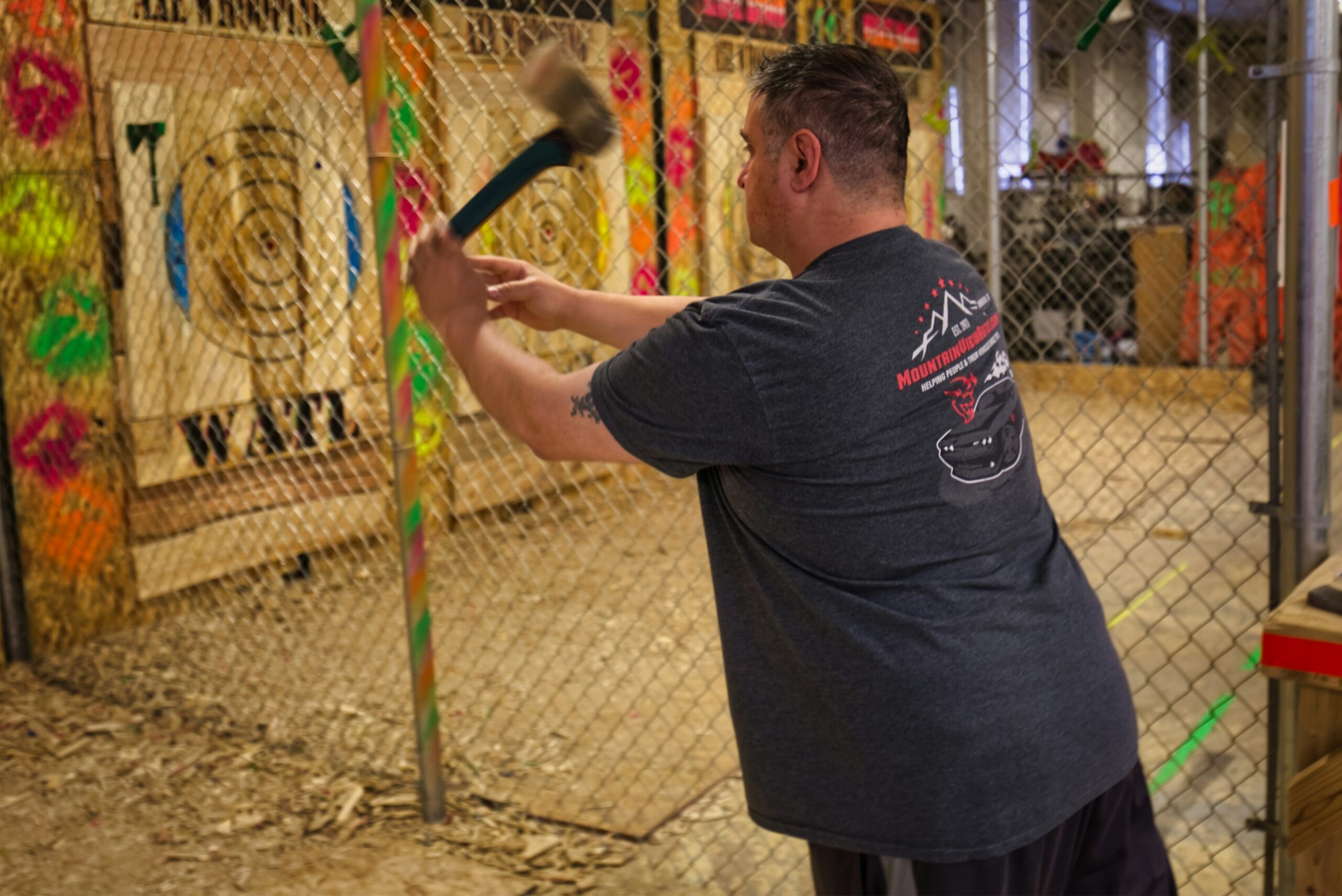Mastering advanced axe-throwing release techniques requires precision and control to ensure each throw is accurate and consistent. This guide focuses on how to improve your release technique for better energy transfer and accuracy without risking strain or injury.
By refining your grip and timing and adapting to different axes and environments, you’ll not only enhance your throwing accuracy but also reduce the chance of mistakes, allowing you to elevate your axe-throwing performance.
Key Takeaways
- Advanced axe throwing requires mastering physics, grip variations, stance, body coordination, and avoiding common errors
- Environmental factors like wind, weather, and lighting significantly impact throwing performance and require adaptation
- Personalized training regimens, including strength exercises and mental techniques, are crucial for improving advanced throwing skills
- Video analysis and progressive goal-setting help throwers identify areas for improvement and maintain motivation
- Adapting techniques for different axe types and maintaining proper equipment care enhances overall throwing performance
Advanced Grip Methods for Expert Axe Throwers

Expert axe throwers use advanced axe-throwing release techniques to boost their performance. These techniques include refining grip styles, balancing finger placement, adjusting grip pressure for different axe weights, and incorporating subtle wrist movements. Paying close attention to every detail, from grip to stance, ensures more precise throws and better overall results.
Exploring the Extended Grip Technique
The extended grip technique, commonly used by expert axe throwers, involves holding the axe further back on the handle to increase throw velocity and control. This method requires precise rhythm and timing, as the additional length between the hand and axe head impacts the overall trajectory. Mastering this technique allows throwers to achieve greater power and accuracy, especially when targeting from varying distances.
Balancing Finger Placement for Stability
Balancing finger placement is essential for stability in axe throwing. Expert throwers position their fingers along the hatchet handle to optimize control and consistency. Proper finger placement helps maintain a stable grip throughout the release, which improves accuracy.
When fingers are positioned closer to the axe head, throwers gain more control but sacrifice power. A middle handle grip offers a balance between control and power while placing fingers at the end of the handle maximizes power but reduces control.
Adjusting Grip Pressure for Different Axe Weights
Expert axe throwers adjust their grip pressure according to the weight of the axe to perfect their overhand throw. Heavier axes require a firmer grip for control, while lighter axes benefit from a relaxed hold to improve fluidity and accuracy.
Throwers develop muscle memory to instinctively adjust grip pressure, ensuring consistent performance across different axe weights and distances. Factors such as axe weight, balance, throwing distance, hand size, strength, desired rotations, and even weather conditions all play a role in determining the ideal grip pressure.
Incorporating Wrist Movement Into the Release
Incorporating wrist movement into the release is a vital technique for expert axe throwers to boost speed and accuracy. The wrist functions like a clock, with the ideal release point at the 12 o’clock position for optimal rotation.
A proper wrist action not only enhances control but also reduces the risk of injury, allowing throwers to adjust based on target distance and axe weight. A 12 o’clock wrist position is considered the optimal release point, while an 11 o’clock release may result in under-rotation, and a 1 o’clock release can lead to over-rotation.
Timing and Rhythm in Axe Release
Timing and rhythm are essential for advanced axe throwing. Throwers need to establish a consistent release point, synchronize their breathing with each motion, and harness momentum to improve accuracy. Practicing timing techniques and adapting to different distances enhances versatility. By mastering these elements, along with proper hand positioning and toe alignment, throwers can achieve optimal spin and precision with every throw.
Developing a Consistent Release Point
Developing a consistent release point is essential for advanced axe throwers aiming to achieve precision and accuracy. The release point, guided by the positioning of the index finger and thumb on the handle, directly affects the throw’s trajectory.
By aligning foot placement with the release point, throwers create a seamless connection between body positioning and axe delivery. Through consistent practice, throwers can build muscle memory, ensuring a reliable and repeatable release technique.
Synchronizing Breathing With Throwing Motion
Synchronizing breathing with the throwing motion enhances precision, especially for sidearm and tomahawk techniques. Advanced throwers exhale steadily as they release the axe, keeping a relaxed grip on the handle.
This coordination helps maintain focus and improves accuracy, particularly when aiming for smaller targets. Mastering this synchronization leads to a more fluid and controlled release, ensuring consistent performance across various throwing styles and distances.
Utilizing Momentum for Increased Accuracy
Effectively utilizing momentum is key to improving accuracy in advanced axe throwing. Experienced throwers use their body’s natural movement to generate power, transferring energy from the forearm through the elbow and into the axe.
This technique, commonly used in competitive settings, relies on precise timing and fluid motion. It begins with a stable stance, followed by a controlled backward motion, then accelerating forward while engaging the entire body.
Throughout the throw, maintaining a relaxed grip is essential, with the axe released at the optimal point for maximum accuracy. Mastering this approach gives throwers a significant edge in competition.
Techniques for Throwing Different Types of Axes

Mastering advanced axe throwing requires adapting techniques for various axe types. This section covers release methods for short-handled axes, throwing double-bit axes, modifying techniques for specialized axes, understanding weight distribution’s impact, and maintenance tips. Each axe type demands unique adjustments to achieve optimal performance and accuracy.
Adapting Release for Short-Handled Axes
Adapting release techniques for short-handled axes requires throwers to adjust their grip and throwing motion. The compact size of these axes demands a tighter grip and a smaller throwing arc, leading to a quicker release.
Throwers focus on generating power through wrist snap and forearm rotation, as the shorter handle provides less leverage for momentum. This adjustment often improves accuracy at shorter distances but may require extra practice to ensure consistency across different ranges.
Throwing Double-Bit Axes Effectively
Throwing double-bit axes effectively requires a unique approach due to their balanced weight distribution. Throwers adjust their grip to accommodate the dual blades, typically positioning their hand closer to the center of the handle for better control.
The release technique emphasizes consistent rotation, with throwers aiming for one full rotation before impact. Advanced throwers also take advantage of the double-bit design by alternating between blades for different throwing styles or distances. This involves adapting the release point for varying ranges and practicing with both blades to ensure symmetrical performance.
Modifying Technique for Custom or Specialized Axes
Modifying techniques for custom or specialized axes requires throwers to adjust their approach based on the unique features of each axe. Advanced throwers carefully assess the weight distribution, handle length, and blade shape to determine the best grip and release method.
They experiment with different distances and rotations to find the ideal technique for each custom axe. Successful adaptation involves evaluating the axe’s balance point, adjusting the grip for optimal control, fine-tuning the release timing based on the axe’s weight, and adapting throwing power to match its aerodynamics. Practicing with various target distances ensures maximum versatility.
Influences of Axe Weight Distribution on Release
The weight distribution of an axe plays a crucial role in the release technique for advanced throwing. Axes with a head-heavy balance require a grip closer to the head for better control, while handle-heavy axes call for a grip near the end to maximize leverage.
Experienced throwers analyze the axe’s center of gravity and adjust their release point to match, often experimenting with different rotations to achieve optimal flight. This adaptation helps ensure consistent accuracy across various axe designs and distances.
Maintenance Tips to Preserve Axe Performance
Proper maintenance is essential for preserving axe performance in advanced throwing. Throwers should regularly sharpen the blade with a whetstone, maintaining a consistent angle to keep the cutting edge sharp. It’s important to inspect the handle for cracks or splinters, sanding and oiling it as needed to prevent wear.
After each session, cleaning the axe head and handle to remove dirt or debris ensures balance and grip remain unaffected. Storing the axe in a dry environment and using protective covers helps prevent rust and damage, ensuring consistent performance over time.
Conclusion
Mastering advanced axe-throwing release techniques is key to improving accuracy, consistency, and overall performance. By understanding grip variations and body mechanics and adapting to different axes and environmental factors, throwers can create a personalized approach that enhances their skills.
Maintaining mental focus and physical conditioning ensures continuous improvement and versatility. Structured training and tools like video analysis can help throwers refine their techniques, leading to greater mastery in this exciting sport.

